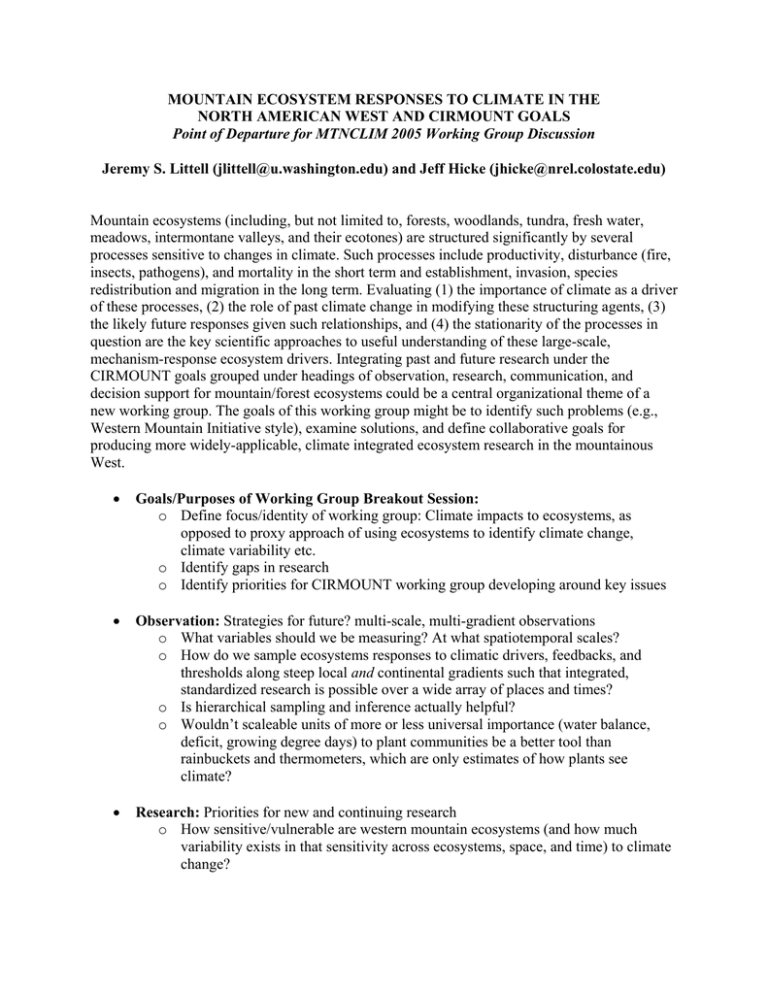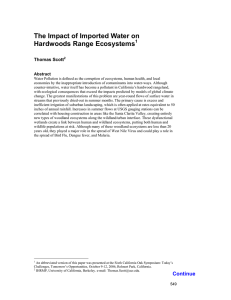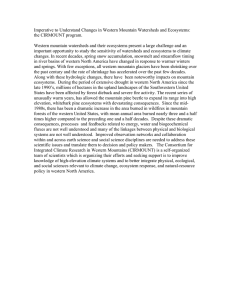MOUNTAIN ECOSYSTEM RESPONSES TO CLIMATE IN THE
advertisement

MOUNTAIN ECOSYSTEM RESPONSES TO CLIMATE IN THE NORTH AMERICAN WEST AND CIRMOUNT GOALS Point of Departure for MTNCLIM 2005 Working Group Discussion Jeremy S. Littell (jlittell@u.washington.edu) and Jeff Hicke (jhicke@nrel.colostate.edu) Mountain ecosystems (including, but not limited to, forests, woodlands, tundra, fresh water, meadows, intermontane valleys, and their ecotones) are structured significantly by several processes sensitive to changes in climate. Such processes include productivity, disturbance (fire, insects, pathogens), and mortality in the short term and establishment, invasion, species redistribution and migration in the long term. Evaluating (1) the importance of climate as a driver of these processes, (2) the role of past climate change in modifying these structuring agents, (3) the likely future responses given such relationships, and (4) the stationarity of the processes in question are the key scientific approaches to useful understanding of these large-scale, mechanism-response ecosystem drivers. Integrating past and future research under the CIRMOUNT goals grouped under headings of observation, research, communication, and decision support for mountain/forest ecosystems could be a central organizational theme of a new working group. The goals of this working group might be to identify such problems (e.g., Western Mountain Initiative style), examine solutions, and define collaborative goals for producing more widely-applicable, climate integrated ecosystem research in the mountainous West. • Goals/Purposes of Working Group Breakout Session: o Define focus/identity of working group: Climate impacts to ecosystems, as opposed to proxy approach of using ecosystems to identify climate change, climate variability etc. o Identify gaps in research o Identify priorities for CIRMOUNT working group developing around key issues • Observation: Strategies for future? multi-scale, multi-gradient observations o What variables should we be measuring? At what spatiotemporal scales? o How do we sample ecosystems responses to climatic drivers, feedbacks, and thresholds along steep local and continental gradients such that integrated, standardized research is possible over a wide array of places and times? o Is hierarchical sampling and inference actually helpful? o Wouldn’t scaleable units of more or less universal importance (water balance, deficit, growing degree days) to plant communities be a better tool than rainbuckets and thermometers, which are only estimates of how plants see climate? • Research: Priorities for new and continuing research o How sensitive/vulnerable are western mountain ecosystems (and how much variability exists in that sensitivity across ecosystems, space, and time) to climate change? o How adaptable are said ecosystems naturally and given the more anthropogenically-constrained environment of the 21st century? o How will ecosystems respond to the interaction of climate change with other environmental changes such as CO2 fertilization, nitrogen deposition, or land-use changes? • Communication: Sharing findings, prioritizing venues etc. o Identify regional and panarchic, meso-scale relationships. Continental and local results are already well established; communication should parallel this. • Decision support: Involving managers, management-specific research o Involve managers on the ground floor: redefine the relationship between the scientific community, which sometimes (and sometimes necessarily) makes management recommendations without fully understanding the needs of resource managers. o Identify more specific needs at appropriate scales for specific agencies and conservation organizations (e.g., The Nature Conservancy), specific systems, structures etc.







